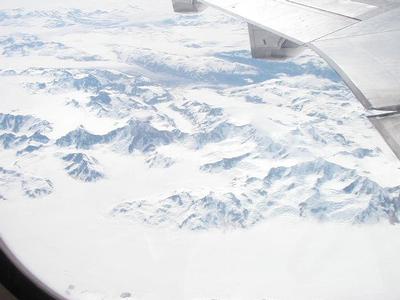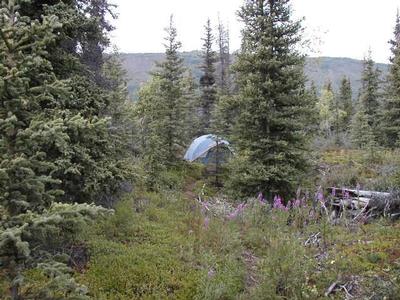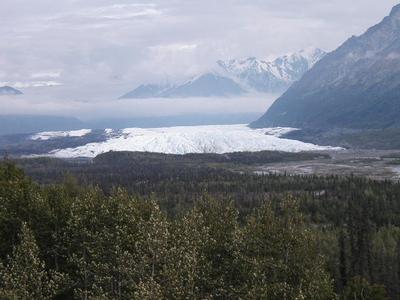
|
|
16 July, 2001
Flight to Alaska & Arrival at camp
10:15 p.m.
Life on the ice.. .. (almost)
I left Columbus at 9 a.m. this morning and arrived in Anchorage at 2:30 p.m.
this afternoon.. .. Add 4 hours for the curve of the Earth, and the trip took
over nine hours. Nine hours is a quick trip to travel to a different world.
I am writing from one of the permanent shelters built by the Cold Regions
Research and Engineering Laboratory (Army Corps of Engineers) looking at the
campfire and, over the treetops, the moraine of the Matanuska Glacier. The
sun has just sunk behind a cloudbank hovering over the mountains to the west.
It is past 10 p.m. and my body, still on Columbus time, tells me it is 2:15
a.m.. My eyes, on the other hand, tell me it can’Äôt be later than 8:00 p.m.
.. .. I heard that the word "day" loses its meaning as one travels north; I
believe it now.
***
Matanuska Glacier is part of an Alaskan State Park and access is controlled
at a small lodge/store about 15-minute walk down the road (where I’Äôll go to
upload journals).
Our camp is comprised of 3 permanent canvas-covered shelters (for lab gear,
food and data analysis), propane-powered grills, a fire pit, several hammocks
and flat spaces hidden among pine trees for individuals to pitch their tents.
Greg and I joined a group of graduate students (Cody, Nick, Michael, James)
at the campsite this afternoon. They are working for the Cold Regions
Research and Engineering Lab as part of a long-term monitoring program of the
glacier, mapping seasonal, daily and even hourly changes.
Several minutes ago, Jeff Strasser, Nelson Hamm, Pat Burkhart (professors
from colleges around the U.S.) arrived with a group of graduate and
undergraduate students (Justin, Meghan, Greg, Andrea and Ranae). The
students will help with existing projects, and will design and conduct an
experiment of their own.
Science at work
After talking with Greg again today, the answer to yesterday’Äôs question
needs
to be revisited, namely, "Why is the this research useful?"
In 1964, the largest earthquake recorded in North America shook Anchorage to
its foundations. Measuring over 8.0 on the Richter scale, in some places,
the ground dropped over 2 meters in a matter of seconds. Anchorage, it turns
out, was built on thixotropic clay , a glacial sediment that has
parcticular properties. If you shake this clay and apply pressure at the same
time, it turns to liquid. (You can model this at home (with parental
permission!): upend a can of solid yogurt on a table, and, then repeatedly
bang the table, the yogurt will turn to liquid before your eyes) This clay,
subjected to pressure from sediment above and shaking from the earthquake,
turned to liquid and shot out into Cook Inlet, creating a tsunami, or
tidal wave. Studying active glaciers can help determine the properties of
glacial sediment. City planners and engineers need to understand the risks
involved with building on glacial sediment. Most of the population of the
United States and Europe lives in areas once covered by glaciers and
therefore on glacial sediment. Most of us, therefore, should take a keen
interest in the properties of the ground beneath our feet.
A second application of the research is to help understand the path of
groundwater, and therefore groundwater pollution. By understanding how
glaciers pick up and deposit sediment in active glaciers (which later become
the matrix for groundwater), we can infer how ancient glaciers picked up and
deposited sediment. The lessons learned on Matanuska can be applied to
once-glaciated areas that cover much of the United States and Europe.
(And it is still a fun thing to know.)
Cheers.
~SM

Nunateks (mountain tops sticking up over the top of ice) can help geologists determine the maximum height of the ice.

My humble home for the next 16 days

Matanuska Glacier
Contact the TEA in the field at
.
If you cannot connect through your browser, copy the
TEA's e-mail address in the "To:" line of
your favorite e-mail package.
|
